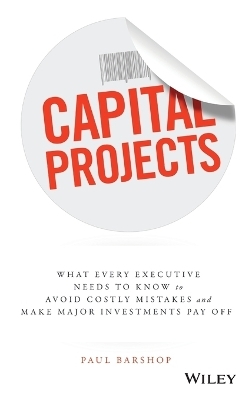
Capital Projects
John Wiley & Sons Inc (Verlag)
978-1-119-11921-0 (ISBN)
A real-world framework for driving capital project success Capital Projects provides an empirically-based framework for capital project strategy and implementation, based on the histories of over 20,000 capital projects ranging from $50,000 to $40 billion. Derived from the detailed, carefully normalized database at preeminent project consultancy IPA, this solid framework is applicable to all types of capital investment projects large and small, in any sector, including technology, life sciences, petroleum, consumer products, and more. Although grounded in empirical research and rigorous data analysis, this book is not an academic discussion or a conceptual dissertation; it's a practical, actionable, on-the-ground guide to making your project succeed. Clear discussion tackles the challenges that cause capital projects to fail or underperform, and lays out exactly what it takes to successfully manage a project using real-world methods that apply at any level.
Businesses report that 60 percent of their projects fail to meet all business objectives, and IPA's database shows that projects' final average net present value undershoots initial estimates by 28 percent. This book provides concrete, actionable solutions to help you avoid the pitfalls and lead the way toward a more positive outcome.
Avoid the missteps that make capital projects fail
Learn the specific practices that drive project success
Understand what effective capital project management entails
Discover real-world best practices that generate more value from capital
When capital projects fail, it is almost always preventable. Inefficiency, underestimated timelines, and unforeseen costs are the primary weights that drag a project down—and they are all avoidable with good management. Capital Projects gives you the insight and practical tools you need to drive a successful project.
PAUL BARSHOP, Director, IPA Capital Solutions, provides hands-on support to companies who are seeking to realize more value by enhancing their capital project development and delivery systems. Previously, he served as both IPA's chief operating officer and director of its Europe, Middle East, and Africa region. He has authored numerous articles for industry trade journals and IPA subscription newsletters.
Acknowledgments ix
1 Falling Short of Expectations: How Executives Struggle to Deliver the Value from Their Capital Projects 1
Background and Basis for the Book 5
Capital Projects Create Value 6
Most Projects Create Less Value Than Expected 7
Results Apply to All Types of Projects 7
Sources of Value Erosion Are Not Limited to Cost and Schedule Overruns 8
How to Deliver the Value Promised 10
2 Why the Stage-Gate Process Is the Best Tool Executives Can Use to Get the Most Value from Their Capital Projects 15
A Necessary Process 19
How Does the Process Work? 20
What Is the Role of Executives in the Process? 25
Stage-Gates and Executive Control 29
3 The Project Frame: Understand the Opportunity before Starting a Project 31
Typical Contents of a Project Frame 34
Unlock Value by Finding a Better Option 35
How to Develop a Project Frame 37
Use the Frame for Executive Alignment and Endorsement 45
4 The Critical Project Sponsor Role 51
Who Is the Project Sponsor? 56
Overview of Project Sponsor Role 58
Assign a Project Sponsor as the Initial Business Case Is Developed 59
Requirements for a Strong Project Sponsor 59
Choosing the Right Project Sponsor 69
5 The Single Most Important Thing an Executive Can Do to Make Any Capital Project Succeed: Define Clear Objectives 75
Business Objectives versus Project Objectives 79
Developing Clear Objectives 79
Communicating the Objectives 84
Prioritizing the Objectives 87
6 The Executive’s Role in Building and Supporting High-Performing Project Teams 91
Executive Leaders Lead 94
Invest in a Strong Owner Project Team 96
Why You Need a Functionally Integrated Team 97
Help the Project Manager Get the Resources for a Functionally Integrated Team 99
Do Not Outsource the Owner Team Role 100
More Experienced Project Teams Do Better Projects 102
Strategies for Coping with Staffing Shortages 102
Executives Working Together to Support the Project 104
7 Project Definition: The Fundamental Capital Project Concept Every Executive Must Understand 107
Strong Project Definition Preserves Value and Produces Better Assets 112
Executives Control the Quality of Project Definition 115
Understand the Cost of Weak Project Definition 116
Be Careful When Trading Fast Schedule for Strong Project Definition 118
Reduce the Number of Schedule-Driven Projects 122
More Project Definition Is Not Necessarily Better 122
8 It’s Going to Cost How Much!?! A Guide to Help Executives Avoid Capital Cost Surprises 125
Key Concepts to Understand about Capital Cost Estimate Accuracy 128
Factor the Cost Estimate Range into Decision Making 129
Improve Project Definition to Narrow the Cost Estimate Range 136
Follow These Rules to Get Contingency Right 140
9 Using a Project Steering Committee to Improve Executive Decision Making 147
How to Build a Strong Steering Committee 150
Who to Include in the Steering Committee 152
Run the Steering Committee Efficiently 154
Make Decisions at the Right Level 155
Do Not Dilute Project Sponsor Accountability 156
10 Risk Management: A Mechanism to Understand Project Risk and Decide What to Do 159
Risk Management: Identify, Analyze, and Manage Individual Risks 164
Practices for Getting the Most from Risk Management 166
Scrutinize Risks to Decide Whether They Are Worth Taking 167
Understand That the Estimate of the Risk Is Probably Too Low 168
Be Careful with Making Late Changes in Response to Business Risk 169
Strong Risk Management Does Not Substitute for Strong Project Definition 171
11 Approve, Recycle, Cancel, or Hold: Making Good Stage-Gate Decisions 173
Capital Investment Decisions Are Made at the Stage-Gates 176
Three Gates Provide Adequate Control 177
The Business Question Asked and Answered at Each Stage-Gate 179
Use Your Early Stage-Gates Better 180
Four Choices for the Stage-Gate Decision 181
Information Used in an Investment Decision 182
Rules for Strong Gates 183
The Slippery Slope of Granting Exceptions to Stage-Gate Deliverables 189
12 Executive Role, Executive Control: 12 Essential Rules 193
Rule 1: Use the Stage-Gate Process 195
Rule 2: Start by Framing the Project 195
Rule 3: Ensure Project Sponsor Involvement 196
Rule 4: Develop Clear Objectives 196
Rule 5: Invest in Owner Teams and Provide the Support They Need 197
Rule 6: Reach a Strong Level of Project Definition 198
Rule 7: Factor the Accuracy of the Capital Cost Estimate into Decision Making 199
Rule 8: Set Contingency in Accordance with Project Risk 199
Rule 9: Build an Effective Steering Committee 200
Rule 10: Use a Robust Risk Management Process 200
Rule 11: Keep the Stage-Gates Strong 200
Rule 12: Be Coachable 201
Glossary 203
Index 207
| Verlagsort | New York |
|---|---|
| Sprache | englisch |
| Maße | 160 x 231 mm |
| Gewicht | 408 g |
| Themenwelt | Wirtschaft ► Betriebswirtschaft / Management ► Unternehmensführung / Management |
| ISBN-10 | 1-119-11921-9 / 1119119219 |
| ISBN-13 | 978-1-119-11921-0 / 9781119119210 |
| Zustand | Neuware |
| Haben Sie eine Frage zum Produkt? |
aus dem Bereich


